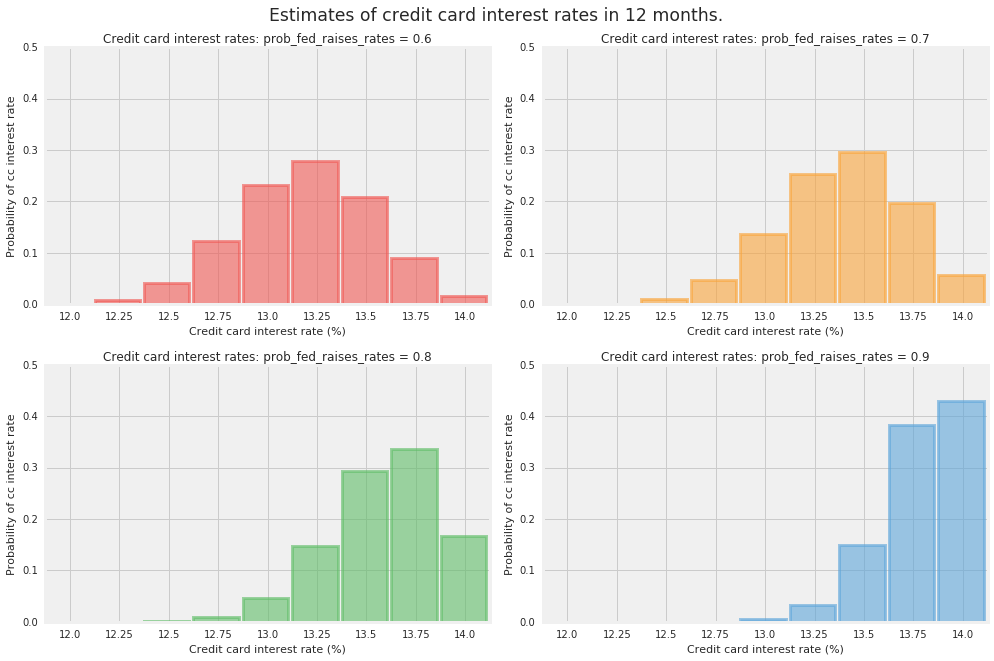 Esegui in Google Colab Esegui in Google Colab |  Visualizza la fonte su GitHub Visualizza la fonte su GitHub |
Immaginiamo che tu voglia stimare il tasso di interesse sulla tua carta di credito tra un anno. Supponiamo che l'attuale tasso primario sia del 2% e che la società della tua carta di credito ti addebiti il 10% più il tasso prime. Data la forza dell’economia attuale, ritieni che sia più probabile che la Federal Reserve aumenti i tassi di interesse piuttosto che no. La Fed si riunirà otto volte nei prossimi dodici mesi e alzerà il tasso dei fondi federali dello 0,25% oppure lo lascerà al livello precedente.
Utilizziamo la distribuzione binomiale per modellare il tasso di interesse della tua carta di credito alla fine del periodo di dodici mesi. Nello specifico, utilizzeremo la classe di distribuzione binomiale di probabilità di TensorFlow con i seguenti parametri: total_count = 8 (numero di prove o riunioni), probs = {.6, .7, .8, .9}, per il nostro intervallo di stime su la probabilità che la Fed aumenti il tasso dei fondi federali dello 0,25% ad ogni riunione.
Dipendenze e prerequisiti
Impostazioni di installazione della probabilità di TensorFlow
TFP_Installation = "Stable TFP"
if TFP_Installation == "Most Recent TFP":
!pip install -q tfp-nightly
print("Most recent TFP version installed")
elif TFP_Installation == "Stable TFP":
!pip install -q --upgrade tensorflow-probability
print("Up-to-date, stable TFP version installed")
elif TFP_Installation == "Stable TFP-GPU":
!pip install -q --upgrade tensorflow-probability-gpu
print("Up-to-date, stable TFP-GPU version installed")
print("(make sure GPU is properly configured)")
elif TFP_Installation == "Most Recent TFP-GPU":
!pip install -q tfp-nightly-gpu
print("Most recent TFP-GPU version installed")
print("(make sure GPU is properly configured)")
elif TFP_Installation == "TFP Already Installed":
print("TFP already installed in this environment")
pass
else:
print("Installation Error: Please select a viable TFP installation option.")
Importazioni e variabili globali (assicurati di eseguire questa cella)
from __future__ import absolute_import, division, print_function
warning_status = "ignore"
import warnings
warnings.filterwarnings(warning_status)
with warnings.catch_warnings():
warnings.filterwarnings(warning_status, category=DeprecationWarning)
warnings.filterwarnings(warning_status, category=UserWarning)
import numpy as np
import os
matplotlib_style = 'fivethirtyeight'
import matplotlib.pyplot as plt; plt.style.use(matplotlib_style)
import matplotlib.axes as axes;
from matplotlib.patches import Ellipse
%matplotlib inline
import seaborn as sns; sns.set_context('notebook')
notebook_screen_res = 'png'
%config InlineBackend.figure_format = notebook_screen_res
import tensorflow as tf
# Eager Execution
use_tf_eager = True
# Use try/except so we can easily re-execute the whole notebook.
if use_tf_eager:
try:
tf.compat.v1.enable_eager_execution()
except:
reset_session()
import tensorflow_probability as tfp
tfd = tfp.distributions
tfb = tfp.bijectors
def default_session_options(enable_gpu_ram_resizing=True,
enable_xla=False):
"""Creates default options for Graph-mode session."""
config = tf.ConfigProto()
config.log_device_placement = True
if enable_gpu_ram_resizing:
# `allow_growth=True` makes it possible to connect multiple
# colabs to your GPU. Otherwise the colab malloc's all GPU ram.
config.gpu_options.allow_growth = True
if enable_xla:
# Enable on XLA. https://www.tensorflow.org/performance/xla/.
config.graph_options.optimizer_options.global_jit_level = (
tf.OptimizerOptions.ON_1)
return config
def reset_session(options=None):
"""Creates a new global, interactive session in Graph-mode."""
if tf.executing_eagerly():
return
global sess
try:
tf.reset_default_graph()
sess.close()
except:
pass
if options is None:
options = default_session_options()
sess = tf.InteractiveSession(config=options)
def evaluate(tensors):
"""Evaluates Tensor or EagerTensor to Numpy `ndarray`s.
Args:
tensors: Object of `Tensor` or EagerTensor`s; can be `list`, `tuple`,
`namedtuple` or combinations thereof.
Returns:
ndarrays: Object with same structure as `tensors` except with `Tensor` or
`EagerTensor`s replaced by Numpy `ndarray`s.
"""
if tf.executing_eagerly():
return tf.contrib.framework.nest.pack_sequence_as(
tensors,
[t.numpy() if tf.contrib.framework.is_tensor(t) else t
for t in tf.contrib.framework.nest.flatten(tensors)])
return sess.run(tensors)
class _TFColor(object):
"""Enum of colors used in TF docs."""
red = '#F15854'
blue = '#5DA5DA'
orange = '#FAA43A'
green = '#60BD68'
pink = '#F17CB0'
brown = '#B2912F'
purple = '#B276B2'
yellow = '#DECF3F'
gray = '#4D4D4D'
def __getitem__(self, i):
return [
self.red,
self.orange,
self.green,
self.blue,
self.pink,
self.brown,
self.purple,
self.yellow,
self.gray,
][i % 9]
TFColor = _TFColor()
Calcolare le probabilità
Calcolare le probabilità dei possibili tassi di interesse delle carte di credito in 12 mesi.
# First we encode our assumptions.
num_times_fed_meets_per_year = 8.
possible_fed_increases = tf.range(
start=0.,
limit=num_times_fed_meets_per_year + 1)
possible_cc_interest_rates = 2. + 10. + 0.25 * possible_fed_increases
prob_fed_raises_rates = tf.constant([0.6, 0.7, 0.8, 0.9]) # Wild guesses.
# Now we use TFP to compute probabilities in a vectorized manner.
# Pad a dim so we broadcast fed probs against CC interest rates.
prob_fed_raises_rates = prob_fed_raises_rates[..., tf.newaxis]
prob_cc_interest_rate = tfd.Binomial(
total_count=num_times_fed_meets_per_year,
probs=prob_fed_raises_rates).prob(possible_fed_increases)
Esegui il codice TF
# Convert from TF to numpy.
[
possible_cc_interest_rates_,
prob_cc_interest_rate_,
prob_fed_raises_rates_,
] = evaluate([
possible_cc_interest_rates,
prob_cc_interest_rate,
prob_fed_raises_rates,
])
Visualizza i risultati
plt.figure(figsize=(14, 9))
for i, pf in enumerate(prob_fed_raises_rates_):
plt.subplot(2, 2, i+1)
plt.bar(possible_cc_interest_rates_,
prob_cc_interest_rate_[i],
color=TFColor[i],
width=0.23,
label="$p = {:.1f}$".format(pf[0]),
alpha=0.6,
edgecolor=TFColor[i],
lw="3")
plt.xticks(possible_cc_interest_rates_ + 0.125, possible_cc_interest_rates_)
plt.xlim(12, 14.25)
plt.ylim(0, 0.5)
plt.ylabel("Probability of cc interest rate")
plt.xlabel("Credit card interest rate (%)")
plt.title("Credit card interest rates: "
"prob_fed_raises_rates = {:.1f}".format(pf[0]));
plt.suptitle("Estimates of credit card interest rates in 12 months.",
fontsize="x-large",
y=1.02)
plt.tight_layout()


